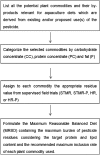Dietary burden calculations relating to fish metabolism studies
- PMID: 26749492
- PMCID: PMC5067560
- DOI: 10.1002/jsfa.7607
Dietary burden calculations relating to fish metabolism studies
Abstract
Fish farming is increasingly dependent on plant commodities as a source of feed leading to an increased risk for pesticide residues in aquaculture diets and consequently their transfer into aquaculture food products. The European pesticide regulation requires fish metabolism and fish feeding studies where residues in fish feed exceed 0.1 mg kg(-1) of the total diet (dry weight basis) to enable the setting of appropriate maximum residue levels in fish commodities. Fish dietary burden calculation is therefore an important prerequisite to decide on further experimental testing as part of the consumer risk assessment. In this review, the different aquaculture production systems are compared with regard to their specific feeding practices and the principles of dietary burden calculation are described.
Keywords: aquaculture; dietary exposure; feed residues; fish feeding; pesticide regulation; risk assessment.
© 2016 The Authors. Journal of the Science of Food and Agriculture published by John Wiley & Sons Ltd on behalf of Society of Chemical Industry.
Figures
References
-
- Food and Agriculture Organization of the United Nations (FAO) , State of the World Fisheries and Aquaculture 2014. FAO, Rome, pp. 3–20 (2014).
-
- Food and Agriculture Organization of the United Nations (FAO) , Fisheries and Aquaculture Department, Statistics and Information Service FishStatJ: Universal Software for Fishery Statistical Time Series. FAO, Rome: (2011).
-
- Edwards P, Pullin RSV and Gartner JA, Research and Education for the Development of Integrated Crop–Livestock–Fish Farming Systems in the Tropics, ICLARM Studies and Reviews. International Center for Living Aquatic Resources Management (ICLARM), Manila: (1988)
-
- Tacon AGJ, The Nutrition and Feeding of Farmed Fish and Shrimp – A Training Manual, no. 3. Feeding Methods. FAO Field Document, Project GCP/RLA/075/ITA. Field Document 7/E. FAO, Brasilia: (1988).
-
- Prein M, Integration of aquaculture into crop–animal systems in Asia. Agric Syst 71:127–146 (2002).
Publication types
MeSH terms
Substances
LinkOut - more resources
Full Text Sources
Other Literature Sources


